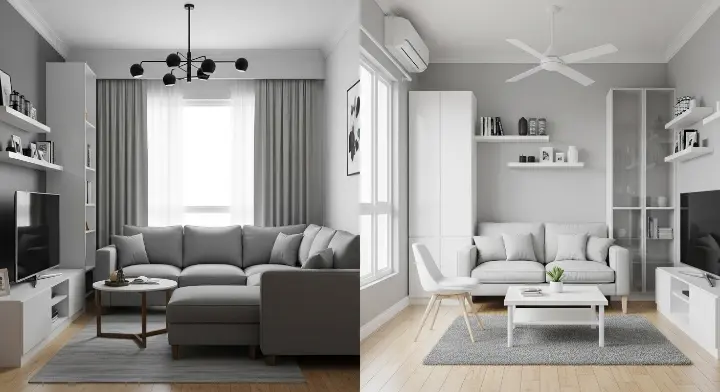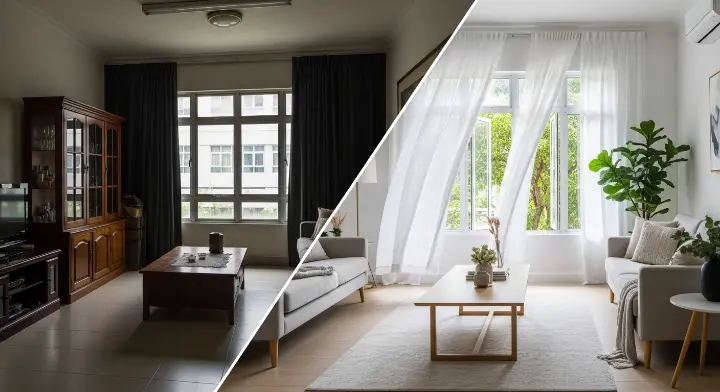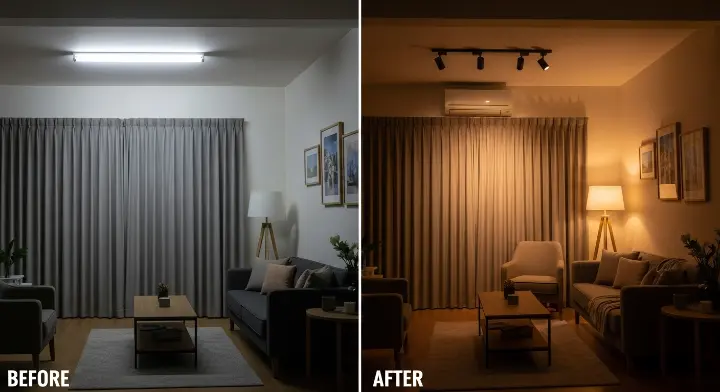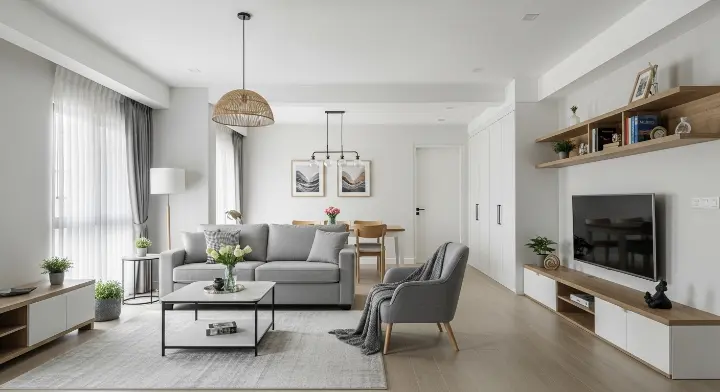Let's be honest—we've all seen (or made!) those interior design choices that looked good in our heads but didn't quite work out in reality. Maybe it's that massive sofa that swallowed your living room, or the gorgeous white rug that became a cleaning nightmare in our humid Malaysian climate.
The good news? Most design mistakes are totally fixable, and even better, completely avoidable once you know what to look out for. After working on 30+ renovation projects across Klang Valley, we've seen these same issues pop up again and again in Malaysian homes—from cosy condos in Petaling Jaya to spacious terraces in Shah Alam.
In this post, I'm sharing the 7 most common interior design mistakes we see Malaysian homeowners make, and more importantly, simple solutions that actually work for our tropical climate and local lifestyle. Whether you're renovating your first condo or refreshing your family home, these tips will save you time, money, and plenty of regret!
 Mistake #1: Ignoring Our Tropical Climate When Choosing Materials
Mistake #1: Ignoring Our Tropical Climate When Choosing Materials
The Problem: This is the biggest mistake we see! Malaysian homeowners fall in love with beautiful materials and finishes they see in international design magazines, without considering how they'll hold up in our year-round humidity and heat.
We've seen gorgeous solid wood flooring warp within months, pristine white sofas develop mysterious dark spots (hello, mould!), and expensive wallpaper peel off walls because of moisture buildup. Our 80-90% humidity levels and heavy rainfall aren't just minor inconveniences—they're serious factors that affect every material choice in your home.
The Solution: Always prioritise humidity-resistant and heat-tolerant materials:
For walls:
- Choose anti-fungal, mould-resistant paint like Nippon Paint's Odour-less Premium (around RM240-280 per 5L) or Dulux Weathershield (RM140-170 per 5L)
- If you love wallpaper, go for vinyl or non-woven types that resist moisture better than paper-based options
- Consider waterproof wall panels for bathrooms and wet areas
For flooring:
- Porcelain or ceramic tiles are your best friend (widely available at Guocera or Roman Ceramics, starting from RM15 per sq ft)
- If you prefer wood-look, opt for wood-like tiles or engineered timber with good moisture resistance
- Avoid solid hardwood in ground floor areas or anywhere prone to water exposure
For furniture:
- Choose synthetic rattan or treated wood for outdoor furniture (check IKEA's outdoor range, RM300-2,000)
- For upholstery, select fabrics with anti-bacterial and stain-resistant treatment
- Avoid pure cotton or linen in high-humidity areas—go for synthetic blends that dry faster
Pro tip: Before buying anything, ask the salesperson: "Is this suitable for Malaysia's humid climate?" If they hesitate, walk away!

Mistake #2: Buying Oversized Furniture for Small Malaysian Homes
The Problem: That luxurious 3-seater sofa looked perfect in the Courts showroom, but now it's blocking your walkway and making your 800 sq ft condo living room feel like a furniture warehouse. Many Malaysians buy furniture based on how it looks in large showrooms, forgetting that typical condo living rooms are only 150-250 sq ft.
Oversized furniture doesn't just look cramped—it actually makes your space feel smaller and disrupts traffic flow, especially important in Malaysian homes where we're constantly moving between the living area, dining area, and kitchen.
The Solution: Measure everything before you buy (yes, really!):
- Measure your room dimensions (length x width)
- Measure doorways and hallways (can the furniture even fit through?)
- Use masking tape on the floor to outline furniture footprints before purchasing
- Leave at least 2.5-3 feet of walkway space around major furniture pieces
Size guidelines for common Malaysian homes:
For 600-800 sq ft condos:
- Sofa: 72-84 inches (6-7 feet) max length
- Coffee table: 36-42 inches long
- Dining table: 4-seater (48 inches) is more practical than 6-seater
For 900-1,200 sq ft condos:
- Sofa: 84-96 inches (7-8 feet)
- Coffee table: 42-48 inches
- Dining table: 6-seater (60-72 inches)
Smart alternatives:
- L-shaped sofas utilise corners efficiently (check IKEA's KIVIK range, around RM2,500-4,000)
- Extendable dining tables save space daily but accommodate guests during kenduri or open houses
- Slim-profile furniture with raised legs creates visual lightness

Mistake #3: Blocking Natural Light and Ventilation
The Problem: With our electricity bills (thanks, TNB!), you'd think we'd all be maximising free natural light and ventilation, right? But we often see homeowners blocking windows with heavy curtains, pushing large furniture against window walls, or worse—closing off windows entirely for more wall space.
In Malaysian homes, natural ventilation isn't just nice to have—it's essential for reducing mould, keeping spaces fresh, and lowering your aircon bills. Every closed window is money added to your monthly electricity costs!
The Solution: Embrace and enhance natural light flow:
Window treatments:
- Use sheer curtains during the day (lets light in whilst maintaining privacy)
- Install dual-layer curtains: sheer + blackout, so you can control light and heat as needed
- Consider top-down bottom-up blinds for condos facing other buildings (privacy + light!)
- Budget option: Affordable sheer curtains from MR.DIY or Shopee start from RM30-80
Furniture placement:
- Keep at least 1 foot clearance between furniture and windows
- Don't place tall bookshelves or wardrobes directly in front of windows
- Position your sofa to face natural light sources when possible
Maximise cross-ventilation:
- Keep opposite windows/doors open to create airflow
- Install ceiling fans strategically (from RM200-500 at local electrical shops like TBM or ESH)
- Use ceiling fans to reduce aircon usage: fans consume far less electricity (about 50-75 watts vs aircon's 1000-2000 watts!)
Pro tip: In Malaysian afternoons when the sun is intense, close curtains on west-facing windows to keep heat out, but keep other windows open for airflow. This reduces the need for air conditioning by 30-40%!

Mistake #4: Choosing the Wrong Colour Palettes for Small Spaces
The Problem: Dark, bold colours can look stunning in spacious landed properties or high-ceiling condos, but they can make typical Malaysian apartment living rooms (150-200 sq ft) feel cave-like and oppressive—especially when combined with our limited natural light.
We've seen homeowners paint entire small bedrooms in dark navy or deep grey, then wonder why the room feels so cramped and gloomy, even with lights on!
The Solution: Use colour strategically to enhance space:
For small condos and apartments (under 1,000 sq ft):
- Stick to light, neutral base colours: off-white, light grey, beige, soft taupe
- Popular Malaysian-friendly shades: Nippon's "Natural White", Dulux's "Whisper White" or "Hog Bristle"
- Use the 60-30-10 rule: 60% neutral base, 30% secondary colour, 10% accent colour
Where to add dark colours:
- Single accent walls (behind the sofa, bed headboard wall)
- Lower half of walls in split-tone designs
- Built-in cabinetry or feature elements (not whole walls)
Malaysian climate-friendly colours:
- Light blues and greens: Feel cooling and fresh (perfect for our hot weather!)
- Warm beiges and taupes: Hide dust better than pure white (practical in tropical climate)
- Soft greys: Modern and forgiving with Malaysian lighting
Colours to avoid in small Malaysian homes:
- Pure white (shows every spot of dirt, dust, and humidity marks)
- Very dark walls (absorb light and make spaces feel smaller)
- Overly bright colours (can feel overwhelming in our intense tropical sunlight)
Budget tip: Can't decide? Get small paint sample pots (RM15-25 each) and test on your actual walls. Observe how they look at different times of day in Malaysian lighting—trust me, colours look very different here compared to temperate countries!
 Mistake #5: Neglecting Proper Storage Solutions
Mistake #5: Neglecting Proper Storage Solutions
The Problem: Malaysian families accumulate a lot—from kids' school supplies to multiple sets of festive decorations (Raya, CNY, Deepavali, Christmas!), not to mention our shoes-off culture means we need proper shoe storage for the whole family plus guests.
Without adequate built-in storage, clutter takes over, making even beautifully designed homes look messy and feel stressful. Open shelves become dumping grounds, and countertops disappear under piles of stuff.
The Solution: Design for storage from the start:
Entry zones:
- Built-in shoe cabinets (essential for Malaysian homes!) - budget RM800-2,500 depending on size
- Wall hooks for bags and umbrellas (rain happens suddenly here!)
- Small bench with storage underneath for sitting whilst putting on shoes
Living areas:
- TV consoles with closed storage (hides clutter, RM500-2,500 from IKEA or Courts)
- Coffee tables with hidden compartments
- Floating shelves for display, closed cabinets for storage
Bedrooms:
- Built-in wardrobes floor-to-ceiling (maximise vertical space) - expect RM2,000-6,000 for a standard 8-foot wardrobe
- Use wardrobe organisers and dehumidifiers (mould prevention!)
- Under-bed storage (but ensure good airflow to prevent moisture buildup)
Kitchens:
- Extend cabinets to the ceiling (no wasted space + less dust accumulation)
- Pull-out drawers > deep cabinets (easier to access everything)
- Vertical storage for trays and cutting boards
Smart storage for Malaysian homes:
- Store out-of-season items (rarely needed in our weather!) in vacuum bags
- Use clear containers so you can see contents (prevents buying duplicates)
- Dedicate space for festive decorations (it's a lot for multi-cultural families!)
 Mistake #6: Poor Lighting Planning
Mistake #6: Poor Lighting Planning
The Problem: Many Malaysian homes rely solely on harsh overhead ceiling lights (those standard 3-4 bulb fixtures that come with the property). The result? Flat, unflattering lighting that makes your beautifully designed space look lifeless—and creates headache-inducing glare on your TV screen!
Proper lighting isn't just about brightness; it's about creating ambiance, defining zones, and making your home feel warm and inviting. Especially important for Malaysian homes where we spend most evenings indoors due to the heat!
The Solution: Follow the 3-layer lighting rule:
Layer 1: Ambient (general lighting)
- Ceiling lights provide overall illumination
- Add dimmer switches (around RM50-150 per switch, easy DIY from MR.DIY)
- Consider LED panel lights for even, soft distribution (more energy-efficient than traditional bulbs)
Layer 2: Task lighting
- Reading lamps beside your sofa or bed
- Under-cabinet lighting in kitchens (especially important for wet kitchens!)
- Desk lamps for home office or study areas
- Budget: RM50-300 per lamp from IKEA, Mr. Light, or online
Layer 3: Accent lighting
- Table lamps on side tables (creates warm pools of light)
- Floor lamps in corners (fills dark spots)
- LED strip lights behind TV or under cabinets (around RM30-80 from Shopee)
- Wall sconces (adds elegance, RM100-500)
Malaysian climate considerations:
- Choose LED bulbs (way more energy-efficient = lower TNB bills!)
- Opt for "warm white" (2700-3000K) for living areas—feels cosy
- Use "cool white" (4000-5000K) for kitchens and bathrooms—feels clean and bright
- Avoid too many recessed downlights (heat buildup in our already warm climate)
Real example: Instead of one RM200 ceiling light for your living room, invest in 1 ceiling light (RM100) + 2 table lamps (RM80 each) + 1 floor lamp (RM150) = RM410 total. The difference in ambiance is incredible, and you'll actually enjoy spending time in your space!
 Mistake #7: Following Trends Without Considering Long-Term Practicality
Mistake #7: Following Trends Without Considering Long-Term Practicality
The Problem: That trendy terrazzo floor looked amazing on Instagram, but can you handle the maintenance in Malaysia's dusty, humid environment? Or that expensive white marble countertop that now shows every tiny stain from your daily cooking?
We see homeowners investing heavily in trendy finishes (industrial concrete walls, all-black bathrooms, velvet furniture) without thinking about cleaning, maintenance, and whether it suits their actual lifestyle—especially challenging in our tropical climate where everything gets dirty and damp faster!
The Solution: Think lifestyle-first, trends second:
Ask yourself these questions before committing to any design trend:
- Can I clean/maintain this easily in Malaysia's humidity?
- Will this look good after 5 years, or will I regret it?
- Does this suit my daily routine (kids? Pets? Cooking style?)
- Can I afford the upkeep (special cleaning products, regular maintenance)?
Practical Malaysian alternatives to trendy choices:
Instead of:
- Pure white/light grey grout (stains easily) → Use darker grout colours
- Velvet furniture (absorbs moisture) → Performance fabrics or leather alternatives
- Natural stone everywhere (high maintenance) → Quartz or porcelain that looks like stone
- All-white kitchens (shows every mark) → Two-tone cabinets with darker lowers
- Carpets (mould magnets here!) → Area rugs you can wash or replace
Trends that DO work in Malaysia:
- ✅ Mixed metals (brass, black, steel) - easier to maintain than all-matching
- ✅ Natural materials (rattan, wood) - if properly treated for humidity
- ✅ Indoor plants - thrive in our climate!
- ✅ Open shelving (in some areas) - but needs regular dusting
- ✅ Minimalist designs - less to clean and maintain!
Smart approach:
- Use trendy elements as accents you can easily change (cushions, art, accessories)
- Invest in timeless foundations (neutral floors, classic cabinet styles)
- Try trends in low-commitment areas (paint an accent wall before doing the whole room!)
- Shop smart: Get trendy items from budget stores (Taobao, Shopee, MR.DIY) so you won't feel bad replacing them
 Your Home, Your Rules (But With Smart Choices!)
Your Home, Your Rules (But With Smart Choices!)
Look, nobody's perfect, and even professional designers make mistakes sometimes. The key is learning from common pitfalls so you can create a home that's not just beautiful, but actually works for your Malaysian lifestyle—comfortable in our climate, practical for daily life, and enjoyable for years to come.
Remember these key takeaways:
- Always consider Malaysia's humid tropical climate when selecting materials
- Measure your space before buying furniture (seriously, do it!)
- Maximise natural light and ventilation to save on electricity bills
- Use light colours strategically in small spaces
- Plan for adequate storage from the start
- Layer your lighting for ambiance and function
- Choose practicality over passing trends for major investments
Here's the truth: A well-designed Malaysian home isn't about copying Pinterest boards or mimicking hotel suites—it's about creating a space that handles our weather, fits your lifestyle, works within your budget, and makes you happy every time you walk through the door.
What about you? Have you made any of these mistakes in your own home? Or maybe you discovered a clever solution we didn't mention? Share your experiences in the comments below—we love hearing real stories from Malaysian homeowners!
Need professional help avoiding these mistakes in your renovation? Schedule a free consultation with Reka Interior and let's create a design plan that actually works for your Malaysian home and lifestyle. We've learned from 30+ projects (and yes, a few mistakes of our own!) so you don't have to!